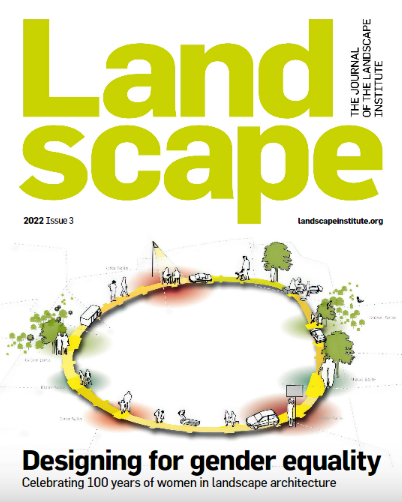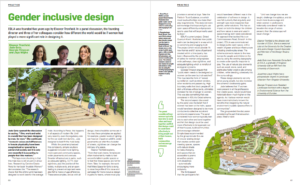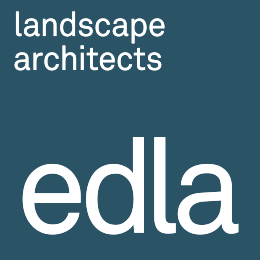
Gender Inclusive Design- Discussion for the Journal of the Landscape Institute
In a recent edition of the Journal for the Landscape Institute, the EDLA team was asked to discuss how gender influences design. The full article is extracted below or the link to the excellent full edition here (Our article is on pages 60-61).
Article begins:
Jade Goto opened the discussion by saying, “I live, work and exist in a world that has been designed by men, for men.” She continued, “women’s voices and differences in female physicality have been marginalised or ignored by a patriarchal society and it is only very recently it is occurring to people that this matters.”
”Perhaps more shocking is that this male bias is still at work in all our lives. Research by Caroline Criado Perez for her book ‘Invisible Women‘ [1] demonstrates this. The research shows that the entire world has been designed to work best for the average male. According to Perez, this happens in all aspects of modern life. Until very recently, even the regulatory size for the car crash test dummy….was designed to best fit the male body.’
Whilst the panel emphasised this complexity, simple solutions suggested included more lighting, more open and community spaces, and wider pavements and avenues. Smarter infrastructure in parks, such as adequate lighting, CCTV, clear sightlines, plus the position of the toilets, multiple exits, and an open feeling to prevent entrapment were also felt to make a huge difference. These are examples, and as with all design, there should be some care in the way these principles are applied: for example, greater levels of lighting can have an impact on wildlife, wider pavements can alter the character of streets, sightlines can change the intimacy of space.
“I live, work and exist in a world that has been designed by men, for men”
Eleanor Trenfield explains, “from their early teens, females are often inadvertently made to feel uncomfortable in public spaces or to feel that these spaces are not for them. Take, for example, the work that Make Space for Girls is doing to raise the profile of this issue and campaign for more inclusive design in parks for teens, where most play provision is aimed at boys. Take the Fields in Trust Guidance, on which most local authorities now base their play requirements. This does not even acknowledge that boys and girls use open space differently and proposes sports uses that will be primarily used by boys”.
EDLA’s current project, Oxted Quarry, Surrey, illustrates how public realm can be designed in a way that is welcoming and engaging to all. The project which would provide 75 new homes and 57 acres of parkland created within a lime quarry, has been influenced by the principles of safety for women and proposes wide pathways, clear sightlines, and adequate lighting which is mindful of ecological concerns.
Georgia Timpson argues that “public realm needs to be designed so women can be seen but not watched”. This may take the form of ‘natural surveillance, such as street vendors, other residents and passers-by. High boundary walls that block people off, or dark unlit areas without exits, ultimately increase the risk of danger to women. This was also something that was considered in EDLA’s Oxted scheme.
The second aspect discussed by the panel was the belief that if women had been at the helm, space would have been designed to be more conducive to collective social and community experiences. The panel considered how women typically lean into each other and bond together and felt that design could be used more effectively to bring people out of their houses, build communities and encourage cohesion. Simple ideas recommended by the group include the use of a circular seating design that creates central open meeting spaces, spaces with natural shade for baby changing, and spaces that are accessible to prams as well as people with disabilities – automatically encouraging more inclusivity.
The third aspect that the participants felt would have been different was the celebration of softness in design. It was felt currently that angularity and strength was more respected than gentler, softer solutions. This has an impact on both the design for children and how nature is seen and used in space-making; both are rarely considered. An approach that tackles this is Commissioners Road, Strood. In this project, EDLA was commissioned to design public open space, with a wealth of green and blue infrastructure including creative play areas. The scheme connects nature to the new homes for people and children in the area by using the existing topography to create a site-specific response to play. The use of natural play elements such as wood, stone, sand, and plants also foster creative play among children, while blending cohesively into the surroundings.
“Women typically lean into to each other and bond together”
These design elements not only serve young people but also increase the scheme’s biodiversity gains.
Jade believes that ‘if women were present in all the professions that create space, nature would have historically been much higher on the agenda. As I believe women would have more instinctively known the benefits that integrating the natural environment in public spaces offers to communities”.
The group ended the discussion considering the part that education plays. Eleanor said:
“Until we change how we are taught, challenge the syllabus, and do much more to encourage and retain women in professions historically considered ‘male’ to broaden the range of voices present, then the status quo will never change.”

